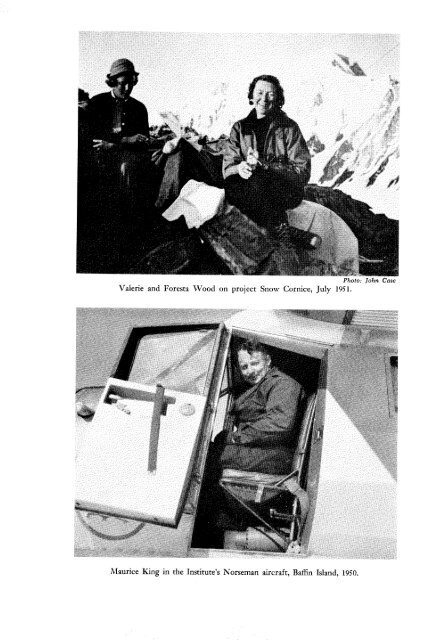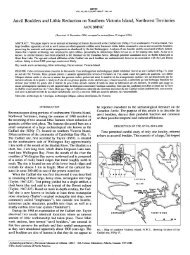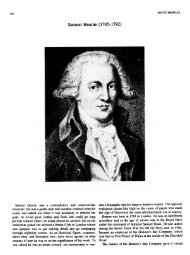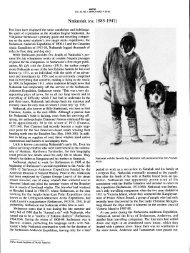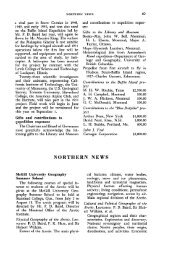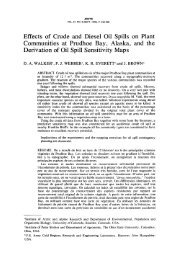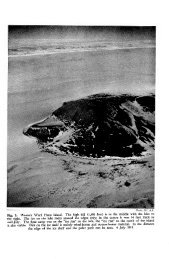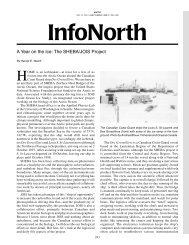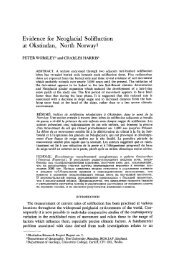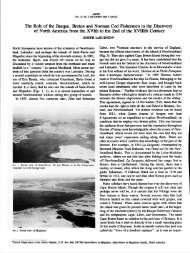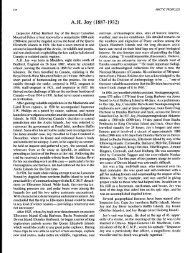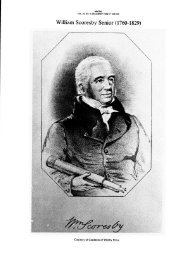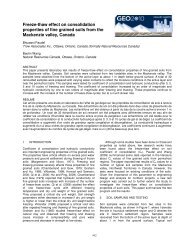Foresta Hodgson Wood, Valerie Wood, Maurice King
Foresta Hodgson Wood, Valerie Wood, Maurice King
Foresta Hodgson Wood, Valerie Wood, Maurice King
Create successful ePaper yourself
Turn your PDF publications into a flip-book with our unique Google optimized e-Paper software.
<strong>Valerie</strong> and <strong>Foresta</strong> <strong>Wood</strong> on project Snow Cornice,<br />
Photo: John Case<br />
July 1951.<br />
<strong>Maurice</strong> <strong>King</strong> in the Institute’s Norseman aircraft, Baffin Island, 1950.
OBITUARY<br />
<strong>Foresta</strong> <strong>Hodgson</strong> <strong>Wood</strong>, <strong>Valerie</strong> <strong>Wood</strong>, <strong>Maurice</strong> <strong>King</strong><br />
The loss of the Institute’s Norseman aircraft, piloted by <strong>Maurice</strong> <strong>King</strong> and<br />
carrying Mrs. Walter A. <strong>Wood</strong> and <strong>Valerie</strong> <strong>Wood</strong>, was mentioned in a brief notice<br />
in the last number of Arctic. The aircraft was taking part in the Institute’s research<br />
project “Snow Cornice”, when it disappeared on 27 July 1951 on a flight from the<br />
research station, in the St. Elias Mountains in the Alaska-Yukon boundary region, to<br />
the base camp at Yakutat, Alaska. Mrs. <strong>Wood</strong>’s husband, Walter A. <strong>Wood</strong>, is the<br />
Director of the Institute’s New York Office and leader of project Snow Cornice.<br />
In spite of an intensive search by the United States Air Force, the Royal Canadian<br />
Air Force, and other official and private groups, in which Mrs. <strong>Wood</strong>’s husband<br />
and son and Mr. <strong>King</strong>’s son participated, no trace of the aircraft has been found<br />
and the occupants are presumed dead.<br />
The Arctic Institute extends its deepest sympathy to their relatives. The<br />
Institute also wishes to express its most grateful thanks to all those who took part<br />
in the search for the Norseman. The following notices are written by Dr. A. L.<br />
Washburn, Director of the Washington Office.<br />
<strong>Foresta</strong> <strong>Hodgson</strong> <strong>Wood</strong><br />
<strong>Foresta</strong> <strong>Hodgson</strong> <strong>Wood</strong>, the daughter of Mrs. Balm Mann <strong>Hodgson</strong> and Caspar<br />
Wistar <strong>Hodgson</strong>, was born in San Francisco, California on 10 November 1904.<br />
<strong>Foresta</strong> attended Horace Mann School, Scarborough School, and Stanford<br />
University. She also studied sculpture at Fontainebleau in France.<br />
Travel and a deep guiding appreciation of the beauty of nature early became<br />
part of <strong>Foresta</strong>’s life. As a child she spent some time in the Phillipine Islands,<br />
travelled in China, Korea, and Japan, and also accompanied her parents on two<br />
trips around the world. Later she spent many childhood summers on her parents<br />
ranch in the California Sierra Nevada, where she made extensive pack trips into<br />
the mountains and gained practical experience in outdoor living. Perhaps more<br />
than anything else these early pack trips were responsible for her love of the<br />
out-of-doors, and especially of mountains and wilderness.<br />
In 1928 she met Walter A. <strong>Wood</strong>, then associated with the American Geographical<br />
Society, and two years later married him in Paris. In 1929 she made<br />
some notable climbs in the Swiss Alps, and was a member of an expedition to the<br />
mountains of Kashmir and Little Tibet that included her future husband, whom<br />
she assisted in a stereo-photogrammetric survey of the Sind-Liddar watershed.<br />
Thus at the time of her marriage <strong>Foresta</strong> had already begun a series of exploratory<br />
travels that few men or women have equalled-travels which were usdertaken<br />
not primarily in the spirit of adventure, although they often constituted adventure<br />
in the real sense of the word, but travels undertaken in partnership with her husband<br />
and in which she contributed her full share to their work. Not only did she become<br />
an indispensable member of the team in organizing and implementing field activities,<br />
but throughout she encouraged and supported her husband’s endeavours.<br />
In 1931 she was in Panama and Guatemala, assisting her husband in astronomical<br />
and survey work, and in 1932 she joined him in an ascent of Neva Toluca in Mexico.<br />
Her son was born during this year and her daughter in the following year. In the<br />
223
224 OBITUARY<br />
summer of 1933, while her husband was absent on an expedition to east Greenland,<br />
she shipped as a crew member on a Finnish square-rigged grain ship.<br />
Two years later <strong>Foresta</strong> and Walter organized and led the <strong>Wood</strong> Yukon<br />
Expedition of the American Geographical Society, on which <strong>Foresta</strong> carried out<br />
a large part of the logistical and photographic work. This expedition initiated an<br />
extensive research program in the Alaska-Yukon region, which was to be <strong>Foresta</strong>’s<br />
major expeditionary contribution and accomplishment during the next sixteen years.<br />
The following summer she participated in the Second <strong>Wood</strong> Yukon Expedition,<br />
in the course of which she accompanied her husband on the first ascents of several<br />
8,000- to 10,000-foot peaks. In 1937 the <strong>Wood</strong>s temporarily left their work in the<br />
Yukon and were members of the American Museum of Natural History Expedition<br />
to the Grand Canyon, on which <strong>Foresta</strong> was again responsible for the logistical and<br />
photographic work. She also made first ascents of Shiva’s Temple and Wotan’s<br />
Throne. In 1937 <strong>Foresta</strong> and Walter returned to the Yukon for the third time and,<br />
in connection with the survey work of the expedition, climbed to 14,000 feet on<br />
Mount <strong>Wood</strong>, named many years before for the late Zachary Taylor <strong>Wood</strong>,<br />
Assistant Commissioner of the Royal Northwest (now Royal Canadian) Mounted<br />
Police. As a member of the Fourth <strong>Wood</strong> Yukon Expedition in 1941, she continued<br />
to carry out extensive and independent photogrammetrical surveying as well as<br />
ground and air photography, and took part in the successful climb of Mount <strong>Wood</strong>,<br />
though she herself was forced to turn back at 14,500 feet because of frozen feet.<br />
All this work was carried out in spite of the fact that she was now the mother of<br />
two children aged nine and ten.<br />
During the War, when her husband was a civilian consultant on mountain<br />
warfare and later an Army and Air Force officer engaged in arctic problems, she<br />
contributed much to the work he was doing. During his service as Assistant<br />
Military Attach6 in Ottawa, she was one of the Canadian Capital’s most charming<br />
and popular hostesses and made many warm friends. Only after the War, when<br />
her husband joined the staff of the Arctic Institute as Director of its New York<br />
Office, did it again become possible for her to work with him in the field.<br />
In 1947 she accompanied him on the first post-war venture, a two months’<br />
reconnaissance of the glaciers of the northeastern St. Elias Mountains. Then in<br />
the following year she participated in initiating the Arctic Institute’s research<br />
project Snow Cornice in the same region, which involved establishing a semi-<br />
permanent glaciological research station on the upper part of the Seward Glacier<br />
among North America’s highest mountains. On this and subsequent Snow Cornice<br />
expeditions (see Arctic, Vol. 1, pp. 107-12; Vol. 2, pp 118-9; Vol. 4, pp. 67-9) she<br />
assumed full responsibility for logistics and carried out much of the ground photo-<br />
graphy and surveying. Her work with Snow Cornice was continued in 1949 and<br />
again in 1951. The fatal accident occurred as she and her daughter <strong>Valerie</strong> were<br />
leaving the Seward Glacier research station to return to the United States.<br />
Thus <strong>Foresta</strong> died, as she had lived, amid the adventure and beauty of some<br />
of the world’s most glorious mountain scenery that she loved so well.<br />
<strong>Foresta</strong>’s accomplishments during the <strong>Wood</strong> Yukon expeditions and her three<br />
seasons with Snow Cornice are without peer for a woman. Much of the success<br />
of the work that was carried out is directly due to her logistical and photographic<br />
contributions. Only those who have seen the expeditionary motion picture records,<br />
for which she was solely responsible, can fully appreciate her attainments as a photo-<br />
grapher-attainments that put her in the forefront of American mountain and<br />
expeditionary photographers.<br />
On meeting <strong>Foresta</strong> in the drawing room it was immediately obvious that she<br />
was a most gracious hostess. To the casual acquaintance it probably seemed un-<br />
thinkable that such a frail-appearing person, who seemed so much at home in the<br />
social and diplomatic life of New York and Ottawa, could also be one of the world’s
OBITUARY 22s<br />
leading mountaineers and expeditionary workers. And yet she was not only all<br />
these things, but to an even greater degree a loving mother and wife and an indis-<br />
pensable helpmate to her husband.<br />
To know <strong>Foresta</strong> was to know the real meaning of a full life and to recognize<br />
strength of character and a deep spiritual devotion to God and to fellow men.<br />
<strong>Valerie</strong> <strong>Wood</strong><br />
<strong>Valerie</strong> <strong>Wood</strong> was born in Zurich, Switzerland on 14 March 1933. She<br />
attended schools in Morristown, Minneapolis, Ottawa, and New York, and graduated<br />
from Brearley School in New York in 1951.<br />
Like her mother she grew to have a fondness and appreciation of nature and<br />
of the out-of-doors through pack trips, which she made to Jasper Park with her<br />
parents in 1946 and 1947. During the latter year she also accompanied them to the<br />
Donjek Ranges of the St. Elias Mountains in the Yukon.<br />
<strong>Valerie</strong> participated in the Institute’s research project Snow Cornice in 1949<br />
and 1951, and in both years she was thoroughly at home and played a full part in<br />
the activities of the expedition.<br />
<strong>Valerie</strong> was a worthy daughter of her mother and in all respects remarkably<br />
like her mother in personality, attractiveness, and meaningful friendship. The<br />
many handwritten inscriptions in her Brearley School class book stand witness to<br />
her popularity.<br />
<strong>Valerie</strong> lived a full and happy life in spite of its brevity, and to those who<br />
knew her there may be comfort in the possibility that she may have been spared<br />
some unforeseen suffering. As it is, her memory will remain an unmarred symbol<br />
of youthful dreams, happiness, and boundless friendship and love-a symbol of<br />
everything that we hold most precious in humanity.<br />
James <strong>Maurice</strong> <strong>King</strong><br />
James <strong>Maurice</strong> <strong>King</strong> was born on 17 December 1900. He learned to fly in<br />
Portland, Oregon, in the late twenties and, after a tour of barn-storming, decided<br />
to go to Alaska in the early thirties.<br />
In Alaska Maury came into his own; During the two decades that followed<br />
he became one of the best-known and most accomplished of the Alaskan bush<br />
pilots in the tradition of such pioneers as Eielson, Crosson, Gillam, and Monson,<br />
to name a few of those who have contributed so much to the development of<br />
aviation in Alaska, and who, like Maury, have now passed on. In fact Maury<br />
represented a race that is tending to vanish and to be replaced by airline pilots,<br />
few of whom have the knowledge of the woods and experience of arctic travelling<br />
that Maury had, or can boast his practical ability under adverse conditions.<br />
Most of Maury’s early flying was done in northwestern Alaska. For a time<br />
he flew with Archie Ferguson out of Kotzebue, and became familiar with every<br />
landmark in the Colville area, Seward Peninsula, and country north to Point Barrow,<br />
under both summer and winter conditions. Subsequent experience with Wien<br />
Airways and Alaska Airlines, among others, gave him equal familiarity with other<br />
parts of Alaska. In 1941 he flew Bradford Washburn over Mount Hayes and the<br />
Alaska Range, on two extended photographic flights.<br />
In 1948 Maury became associated with Walter and <strong>Foresta</strong> <strong>Wood</strong> in the<br />
Institute’s project Snow Cornice. With a specially equipped ski-wheel Norseman<br />
aircraft, he piloted the expedition personnel and equipment between the base at<br />
Yakutat and the upper part of the Seward Glacier among the lofty St. Elias<br />
Mountains. As a result the establishment and supply of the glaciological research
226 OBITUARY<br />
station became a routine operation, except for one episode, which illustrates why<br />
the bush pilots enjoy the reputation they do and why Maury was one of their leaders.<br />
In a landing on the Seward Glacier in 1948, snow conditions were such that,<br />
with the early experimental ski-wheel landing gear, the Norseman nosed over<br />
onto its back, fortunately without serious injury to the occupants. However, an<br />
overturned aircraft, broken wing struts, and a seriously bent propellor were a<br />
major problem as no other aircraft was readily available for rescue operations and<br />
it would have been extremely hazardous to walk out to the Alaskan coast. By<br />
an ingenious arrangement of ropes and the digging of a pit under the bent propellor,<br />
Maury managed to right the aircraft without further damage. He repaired the<br />
broken struts by bracing with two-by-four lumber, and straightened the metal<br />
propellor with jacks stressed against two-by-fours lashed to the propellor. Such<br />
was his skill that the straightened propellor was only one-sixteenth of an inch out<br />
of true. Five days after the accident Maury piloted the Norseman safely back to<br />
Yakutat for permanent repairs, having saved the expedition and salvaged an aircraft<br />
that would normally have been a total loss.<br />
The following summer Maury was again pilot for Snow Cornice, this time<br />
with a much improved ski-wheel combination based on the previous year’s experience.<br />
After two summer seasons it was very desirable to carry out winter investigations<br />
on the Seward Glacier, and early in 1950 Maury successfully flew Walter<br />
and Peter <strong>Wood</strong> up to the research station for a series of observations.<br />
During the summer of 1950 Walter <strong>Wood</strong> loaned the Norseman to P. D. Baird,<br />
Director of the Institute’s Montreal Office, for the Baffin Island Expedition. Maury<br />
was again pilot, and flew the Norseman from Alaska across southern Canada to<br />
Montreal, and then to the east coast of Baffin Island. In spite of his unfamiliarity<br />
with the country he piloted the expedition safely and cheerfully, often through<br />
difficult flying conditions involving both winter- and summer-type operations. It<br />
can truthfully be said that he was in no small measure responsible<br />
of the expedition.<br />
for the success<br />
In 1951 Maury again carried out the flying for the fourth season of project<br />
Snow Cornice. When the fatal crash occurred he was piloting the Norseman from<br />
the Seward Glacier research station to Yakutat. What happened is not known<br />
since no trace of the aircraft has been found, but it is possible that it ran into a<br />
mountain. All those who knew Maury and his ability are confident that whatever<br />
the circumstances were he did everything that could have been done to meet the<br />
situation.<br />
During his life Maury logged some 13,000 hours flying time, of which nearly<br />
half was on skis. Approximately 800 of these hours were spent flying for the<br />
Institute on Snow Cornice and the Baffin Expedition. Although primarily known<br />
as a bush pilot he held both multi-engine and instrument ratings and was a fully<br />
qualified airlines captain. However, Maury’s fame in Alaska was also based on his<br />
reputation as a person as well as on his skill as a pilot. In supplying isolated arctic<br />
or interior posts he always remembered the extra errand that he was asked to do,<br />
frequently doing more than his share in returning with a present of fresh meat or<br />
green vegetables. He carried out many mercy flights under hazardous conditions,<br />
and his indomitable spirit is shown by the fact that when taken sick at a remote<br />
arctic post he piloted his aircraft out despite a ruptured appendix. That his eldest<br />
son Dick, who participated in the search for the Norseman, has become an outstanding<br />
Alaskan pilot counted as one of his great joys.<br />
Maury was a decisive and extremely competent pilot, a man who worked hard,<br />
but who knew how to relax and enjoy himself, a modest person, and a loyal friend.<br />
To those who know and love the North and who appreciate the role that aircraft<br />
have played, Maury will always be particularly remembered as one of the leaders<br />
of that vanishing race to which Alaska owes so much-the bush pilot.<br />
A. L. WASHBURN


